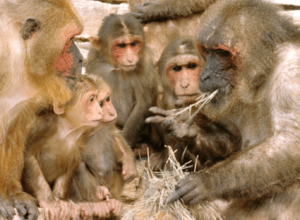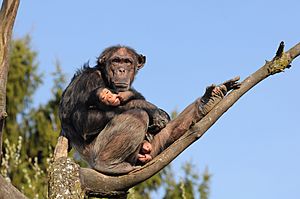Catarrhines facts for kids
Quick facts for kids Catarrhines |
|
|---|---|
 |
|
| Stump-tailed macaques | |
 |
|
| Chimpanzee (Pan troglodytes) at Walter Zoo, Gossau, St. Gallen, Switzerland | |
| Scientific classification |
|
| Kingdom: | Animalia |
| Phylum: | Chordata |
| Class: | Mammalia |
| Order: | Primates |
| Suborder: | Haplorhini |
| Infraorder: | Simiiformes |
| Parvorder: | Catarrhini É. Geoffroy, 1812 |
| Superfamilies | |
|
|
| Synonyms | |
|
|
The group of animals called Catarrhini includes all the monkeys and apes that live in the "Old World." This means places like Africa and Asia. You might also hear them called catarrhine monkeys or Old World monkeys.
In 1812, a scientist named Geoffroy gave them the name Catarrhini. This group includes two main types: the Cercopithecoidea (which are typical Old World monkeys) and the apes (Hominoidea). Even though apes, including humans, are part of this group, some people don't like to call them "monkeys." But scientifically, they are all related. The Catarrhini are closely related to the Platyrrhini, which are the "New World monkeys" found in the Americas.
Scientists believe that the New World monkeys (Platyrrhini) separated from the Old World monkeys (Catarrhini) a very long time ago. They likely traveled from Afro-Arabia (the Old World) to South America, possibly by floating across the ocean!
Contents
What Makes Catarrhines Special?
One of the easiest ways to tell Catarrhines apart from New World monkeys (Platyrrhines) is by looking at their noses.
Nose Shape and Other Features
- Catarrhines have nostrils that point downwards. The word "catarrhine" comes from Ancient Greek words meaning "down" and "nose."
- Platyrrhines (New World monkeys) have nostrils that face sideways. Their name means "flat nose."
Catarrhines also have other unique features:
- They never have prehensile tails. This means their tails can't grasp things like branches, unlike many New World monkeys.
- They have flat fingernails and toenails, just like humans.
- They have a special ear bone that looks like a tube.
- They have fewer premolar teeth than New World monkeys. Their dental formula is 2.1.2.32.1.2.3. This means they have 2 incisors, 1 canine, 2 premolars, and 3 molars on each side of their upper and lower jaws.
Life and Behavior
Many catarrhine species show a lot of sexual dimorphism. This means males and females of the same species can look quite different, often in size or color. They usually don't form lifelong pairs.
Most catarrhines live in social groups, though not all do. Like New World monkeys, they are generally active during the day (they are diurnal). They also have grasping hands and feet, which are great for climbing. Humans are an exception because we walk on two feet.
Apes: A Special Kind of Catarrhine
The term "ape" describes certain types of catarrhines.
What is an Ape?
In everyday talk, an ape usually means a larger catarrhine that doesn't have a tail and often spends time on the ground. For example, the Barbary ape is called an ape even though it's technically a monkey.
In science, the term "ape" has a more specific meaning. It refers to the superfamily called Hominoidea. This group includes two families:
- Hylobatidae: These are the "lesser apes" or gibbons.
- Hominidae: These are the "great apes." This family includes orangutans, gorillas, chimpanzees, bonobos, and humans. It also includes extinct relatives like the australopithecines and the giant ape Gigantopithecus.
How Catarrhines Evolved
Scientists use fossils and genetic information to understand how Catarrhines evolved over millions of years.
Evolutionary Timeline
- New World monkeys split from their Old World relatives about 35 million years ago (Mya).
- The main split within Catarrhines, between the typical Old World monkeys (cercopithecoids) and apes (hominoids), happened around 25 Mya.
- Within the ape group, gibbons separated from the great apes (including humans) about 15-19 Mya.
The first Catarrhines appeared in Africa and Arabia. They didn't show up in other parts of Eurasia until much later, around 18-17 Mya.
Understanding "Monkey" and "Ape"
It can be a bit confusing because scientifically, apes are considered a type of monkey. This is because apes evolved from within the group of Old World monkeys. So, if you define "monkey" broadly, then apes are also monkeys! However, in everyday language, people often use "ape" and "monkey" to mean different things.
Classification of Catarrhines
Here's how Catarrhines fit into the larger family tree of primates:
- Order Primates (all primates)
- Suborder Strepsirrhini: lemurs, lorises, etc.
- Suborder Haplorhini: tarsiers + monkeys, including apes
- Infraorder Tarsiiformes
- Family Tarsiidae: tarsiers
- Infraorder Simiiformes : simians (monkeys, including apes)
- Parvorder Catarrhini (Old World monkeys and apes)
- Infraorder Tarsiiformes
* Superfamily †Propliopithecoidea ** Family †Propliopithecidae (includes Aegyptopithecus) * Superfamily †Pliopithecoidea ** Family †Dionysopithecidae ** Family †Pliopithecidae * Superfamily †Dendropithecoidea ** Family †Dendropithecidae * Superfamily †Saadanioidea ** Family †Saadaniidae * Superfamily Cercopithecoidea (typical Old World monkeys) ** Family Cercopithecidae * Superfamily Hominoidea : apes ** Family Hylobatidae: gibbons ** Family Hominidae: great apes (including humans)
-
-
-
- Parvorder Platyrrhini: New World monkeys
-
-
Images for kids
-
Chimpanzee (Pan troglodytes) at Walter Zoo, Gossau, St. Gallen, Switzerland
See also
 In Spanish: Catarrhini para niños
In Spanish: Catarrhini para niños



